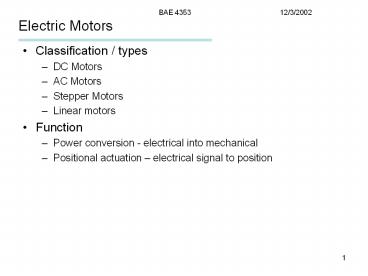Electric Motors - PowerPoint PPT Presentation
1 / 24
Title:
Electric Motors
Description:
locomotives, hoists, cranes, automobile starters. Starting torque ... e.g. cranes. 12/3/2002. BAE 4353. 9. Permanent magnet DC motors. 12/3/2002. BAE 4353. 10 ... – PowerPoint PPT presentation
Number of Views:2293
Avg rating:3.0/5.0
Title: Electric Motors
1
Electric Motors
- Classification / types
- DC Motors
- AC Motors
- Stepper Motors
- Linear motors
- Function
- Power conversion - electrical into mechanical
- Positional actuation electrical signal to
position
2
DC Motors
- DC Motors
- Fundamental characteristics
- Basic function
- Types and applications
- Series
- Shunt
- Combination
- Torque characteristics
- Modeling
3
Fundamental characteristics of DC Motors
End view Time 0
End view Time 0
Shifting magnetic field in rotor causes rotor to
be forced to turn
4
Nature of commutation
- Power is applied to armature windings
- From V
- Through the brush
- Through the commutator contacts
- Through the armature (rotor) winding
- Through the brush
- To V-
- Rotation of the armature moves the commutator,
switching the armature winding connections - Stator may be permanent or electromagnet
5
DC motor wiring topologies
6
Series Wound DC motors
- Armature and field connected in a series circuit.
- Apply for high torque loads that do not require
precise speed regulation. Useful for high
breakaway torque loads. - locomotives, hoists, cranes, automobile starters
- Starting torque
- 300 to as high as 800 of full load torque.
- Load increase results in both armature and field
current increase - Therefore torque increases by the square of a
current increase. - Speed regulation
- Less precise than in shunt motors
- Diminished load reduces current in both armature
and field resulting in a greater increase in
speed than in shunt motors. - No load results in a very high speed which may
destroy the motor. - Small series motors usually have enough internal
friction to prevent high-speed breakdown, but
larger motors require external safety apparatus.
7
Shunt wound DC motors
- Field coil in parallel (shunt) with the armature.
- Current through field coil is independant of the
armature. - Result excellent speed control.
- Apply where starting loads are low
- fans, blowers, centrifugal pumps, machine tools
- Starting torque
- 125 to 200 full load torque (300 for short
periods).
8
Compound wound DC motors
- Performance is roughly between series-wound and
shunt-wound - Moderately high starting torque
- Moderate speed control
- Inherently controlled no-load speed
- safer than a series motor where load may be
disconnected - e.g. cranes
9
Permanent magnet DC motors
10
Permanent Magnet DC Motors
- Have permanent magnets rather than field windings
but with conventional armatures. Power only to
armature. - Short response time
- Linear Torque/Speed characteristics similar to
shunt wound motors. Field magnetic flux is
constant - Current varies linearly with torque.
- Self-braking upon disconnection of electrical
power - Need to short to supply, May need resistance
to dissipate heat. - Magnets lose strength over time and are sensitive
to heating. - Lower than rated torque.
- Not suitable for continuous duty
- May have windings built into field magnets to
re-magnetize. - Best applications for high torque at low speed
intermittent duty. - Servos, power seats, windows, and windshield
wipers.
11
Modeling DC motors
- A linear speed/torque curve can be used to model
DC motors. This works well for PM and compound
designs and can be used for control models for
narrow ranges for the other configurations - Model will assume!
- Linearity
- Constant thermal characteristics
- No armature inductance
- No friction in motor
12
DC Motor modeling
From the circuit
Motor equations
Power is
Substituting the above
And no-load speed
Max power is
In terms of no-load speed torque/speed equation
is
For stalled rotor torque
Units
13
Application
- Use motor voltage and no-load speed to calculate
Kt - Kt Ke in SI units
- Use stalled rotor torque, V, and Ke to find R
- Note, R varies with speed and cannot be measured
at rest - See web download for explanation of Kt, Ke
- http//biosystems.okstate.edu/home/mstone/4353/do
wnloads/ - Development of Electromotive Force.pdf
14
DC motor control H-bridge
- Switches control direction
- A switches closed for clockwize
- B switches for counter-clockwise
- PWM for speed control
- As duty cycle for clockwise speed
- Bs duty cycle for counter-clockwise speed
- Can be configured to brake
- Bottom B and A to brake
15
H-Bridge implementation
- Elements in box are available as single IC
16
Brushless designs
- Commutation is done electronically
- Encoder activated switching
- Hall effect activated switching
- Back EMF driven switching
- PM armature
- Wound/switched fields
- Application
- Few wearing parts (bearings)
- Capable of high speed
- Fractional HP
- Servos
- Low EMC
17
AC Motors
- AC Motors
- Fundamental characteristics
- Types
- Fractional
- Shaded Pole
- Capacitor Start Induction Run
- Integral
- Service Factor
- Insulation class
- Stepper
- Modeling
18
AC motor model
19
AC Motors
- Relationship between number of poles and motor
speed
Poles Speed (RPM)
2 3600
4 1800
6 1200
20
Squirrel Cage Rotor
Seimens AG
21
Torque/speed curve
22
Typical starting current
23
NEMA Motor Characteristics
Design Locked Rotor Torque FL Pull-up Torque FL Breakdown Torque FL Locked Rotor Current FL Slip Efficiency
A 70-275 65-190 175-300 NA 0.5-5 Med-High
B 70-275 65-190 175-300 600-700 0.5-5 Med-High
C 200-285 140-195 190-225 600-700 1-5 Med
D 275 NA 275 600-700 5-8 Low
E 74-190 60-140 160-200 800-1000 0.5-3 High
24
PWM Variable Frequency Drives































